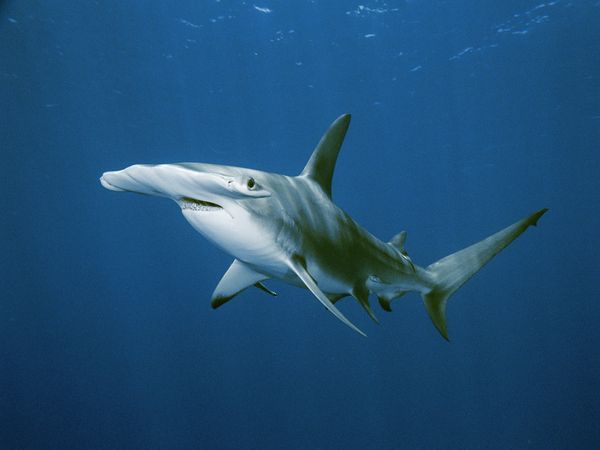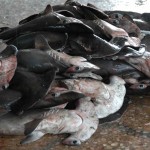 Used as a tasteless thickener in soup and an inconclusive cure all in Ancient Chinese Medicine, shark fin, or more specifically shark finning, claims the lives of more than 70 million sharks annually. Think about that number for a moment; more than 70 million sharks. Portrayed as mindless, blood-thirsty killers in Peter Benchley’s novel Jaws, sharks are persecuted not on what they do, but what they have the capacity to do as conjured up in the human psyche. Is not the alcoholic behind the wheel of a vehicle more of a danger to your family than a shark? In reality, out of the billions of people worldwide that visits the ocean, ~62 humans are attacked each year with only 4.3 resulting in a fatality. So to put this in perspective, sharks kill 4 humans annually and human kill about 70 million sharks. So, who
Used as a tasteless thickener in soup and an inconclusive cure all in Ancient Chinese Medicine, shark fin, or more specifically shark finning, claims the lives of more than 70 million sharks annually. Think about that number for a moment; more than 70 million sharks. Portrayed as mindless, blood-thirsty killers in Peter Benchley’s novel Jaws, sharks are persecuted not on what they do, but what they have the capacity to do as conjured up in the human psyche. Is not the alcoholic behind the wheel of a vehicle more of a danger to your family than a shark? In reality, out of the billions of people worldwide that visits the ocean, ~62 humans are attacked each year with only 4.3 resulting in a fatality. So to put this in perspective, sharks kill 4 humans annually and human kill about 70 million sharks. So, who should be frightened of whom?
should be frightened of whom?
The consumption of shark fin, in any form, dates back to China’s Ming Dynasty roughly 1368-1644 AD. Considered a luxury item in Chinese and Hong Kong cuisine, a bowl of shark fin soup can fetch up to $100. As an alternative medicine, shark fin has been cited as curing cancer and slowing tumor growth; although no claims have been proven in controlled scientific experiments or reported in respected medical journals. On the global market, shark fin can go for $600 US kg ($300 US lb). All over the world, sharks are fished with hooks, some on long-lines, or netted to harvest their fins. Sharks are brought  onto fishing vessels and have their fins sliced off while they are still alive; this practice is termed shark finning. Once the fins are removed the shark’s body is dumped back into the ocean where it plummets to the sea floor and eventually suffocates. No shark species is safe from this dastardly practice; as of 2011, 35% (161 out of 460) of all shark species are now faced with extinction. Chinese argue that it is their right to preserve a cultural tradition that has been around for hundreds of years; conservationists argue the loss of the shark will be the start of the
onto fishing vessels and have their fins sliced off while they are still alive; this practice is termed shark finning. Once the fins are removed the shark’s body is dumped back into the ocean where it plummets to the sea floor and eventually suffocates. No shark species is safe from this dastardly practice; as of 2011, 35% (161 out of 460) of all shark species are now faced with extinction. Chinese argue that it is their right to preserve a cultural tradition that has been around for hundreds of years; conservationists argue the loss of the shark will be the start of the collapse of our oceans.
collapse of our oceans.
The earliest known shark fossil dates back more than 420 million years ago. With a streamlined, cartilaginous skeleton sharks are Mother Nature’s own torpedo; the shortfin mako shark can reach speeds up to 50 km (31 mph). In addition, sharks are found in all seas and can dive to depths greater than 2,000 m (6,600 ft). Currently, there are 460 species of shark identified ranging from the 17 cm (6.7 in) deep sea dwarf lantern shark to the 12 m (39 ft 4 in) whale shark. Sharks are extremely diverse in that, depending on the species, can feed on plankton and squid to large seals and sea lions. The shark has an important job of keeping the oceans clean and populations in check as they will choose the slow and sick animals to feed on first.
 At present time, shark fin legislature is inconsistent at best. Individual countries with a coastline are responsible for their own laws and regulations regarding fishing in their water. Although a complete ban on shark finning would be optimal, most countries only require that the total amount of fins must be in a 5% weight ratio to shark carcasses onboard each boat or that fins must be attached to the shark’s body upon the vessels arrival at port. Regardless, as stated on www.sharkwater.com “Shark finning violates the United Nations Food and Agriculture Organization’s Code of Conduct for Responsible Fisheries.”
At present time, shark fin legislature is inconsistent at best. Individual countries with a coastline are responsible for their own laws and regulations regarding fishing in their water. Although a complete ban on shark finning would be optimal, most countries only require that the total amount of fins must be in a 5% weight ratio to shark carcasses onboard each boat or that fins must be attached to the shark’s body upon the vessels arrival at port. Regardless, as stated on www.sharkwater.com “Shark finning violates the United Nations Food and Agriculture Organization’s Code of Conduct for Responsible Fisheries.”
So what can we do? Whether a friend, foe, or simply scared of the shark, I think we can all agree that shark finning is a brutal and unnecessary practice. Much like ivory, rhino horn, and tiger bones and blood, shark fins are best found on the animals from which they are stolen. Campaigns like “I pledge not to eat shark fin soup” initiated by Shark Savers (www.sharksavers.org) is encouraging those individuals who live in countries where shark fin is commonly consumed to become conscientious consumers. Unfortunately, most people who eat shark fin soup are not aware of the practice in which shark fins are harvested. Public awareness continues to be a powerful tool to allow people to understand how their choices are changing our world; when the demand stops, the killing stops.
stolen. Campaigns like “I pledge not to eat shark fin soup” initiated by Shark Savers (www.sharksavers.org) is encouraging those individuals who live in countries where shark fin is commonly consumed to become conscientious consumers. Unfortunately, most people who eat shark fin soup are not aware of the practice in which shark fins are harvested. Public awareness continues to be a powerful tool to allow people to understand how their choices are changing our world; when the demand stops, the killing stops.